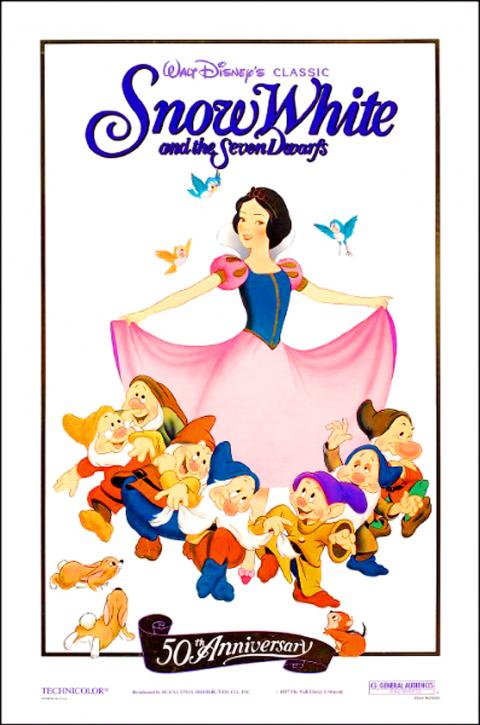Movie posters not only provide an opportunity to appreciate their design, but can also be used to discover the norms of the period when the movie was produced, said Wu Chun-hui (吳俊輝), who has been collecting movie posters and studying their designs for 20 years.
“A movie’s poster is like its business card,” Wu said.
The first movie poster that caught his attention and inspired him to begin collecting posters was that of the 1990 film Ghost, Wu said, adding that the mysterious design left a lot to the imagination.

Photo: Tai Ta-hsiang, Taipei Times
He began searching for the posters of classic foreign films and compared the differences in the poster designs of the same film in different nations, Wu said, adding that he has more than 10,000 posters in his collection.
The design of a movie’s poster is affected by the designers, the production company and the state of the nation in which it is being released, he said.
For example, Poland, which used to be ruled by a communist regime, has a diverse and unique range of poster designs, he said, adding he has collected the most number of posters from that nation.

Photo: Wu Chun-feng, Taipei Times
Unlike movie posters from the US and Europe, which use photographs of the main characters or scenes from the film, Polish movie posters are more like works of art that the designers have created to attract viewers, he said.
“Oftentimes, you can see several avant-garde or thought-provoking designs,” he said.
On the other hand, Japanese movie posters are often influenced by the Ukiyo-e movement, Wu said.
Many early Taiwanese movie posters were created by Chen Tzu-fu (陳子福), who won the Special Award at the 43rd Golden Horse Awards, he said.
Leaving a deep impression in viewers’ minds using a flat piece of paper is a test of the designer’s sense of esthetics and creativity, Wu said.
To commemorate the 50th anniversary of the initial release of Snow White and the Seven Dwarfs, the Walt Disney Co in 1987 designed a new poster for the re-release of the film, he said.
The 1987 poster features color gradients and an excellent use of layers, and the colors are rich, bright and clear, he said.
In the poster, the outlines of Snow White’s dress, the dwarfs’ belts, the title of the movie and the text indicating the film’s 50th anniversary are finished with hot foil stamping, he said.
The intricate design is one of Disney’s representative movie posters, he added.
On the other hand, the majority of Polish poster designer Michael Ksiazek’s designs have women as their theme, he said.
Ksiazek designed a Star Wars poster that was released in 2006, Wu said, adding that only 400 copies were released worldwide.
Through the use of simple lines, Ksiazek depicts women as being graceful yet strong, he said.
Many movie posters also contain historical significance, Wu said.
“On the poster of director Hou Hsiao-hsien’s (侯孝賢) 1985 movie A Time to Live, A Time to Die (童年往事), you can see that the names of some actors and crew members have been covered with black ink,” Wu said.
This is because actors were required to have a license to perform and the names of the actors and extras who did not have the legal qualifications to perform were edited out of the poster, he added.
Two versions of the poster were printed, Wu said, adding that the version he has in his collection is a rare item.
The design and the woodcut used to print the image in the poster were created by graphic designer Liu Kai (劉開), he said.
The image depicts the male protagonist’s state of confusion as he encounters love and relationships with his family and peers, Wu said.
Liu’s poster design is an outstanding example of the way in which movies and their posters can complement each other, he added.
There are several channels through which people can purchase and collect movie posters, including poster stores, individual sellers, other collectors, international auction Web sites, production companies and movie theaters, Wu said.
However, when buyers want to make international purchases, they should choose sellers that have a good reputation, he added.
In terms of the storage and preservation of their posters, collectors should pay attention to humidity, temperature and lighting, Wu said.

Left-Handed Girl (左撇子女孩), a film by Taiwanese director Tsou Shih-ching (鄒時擎) and cowritten by Oscar-winning director Sean Baker, won the Gan Foundation Award for Distribution at the Cannes Critics’ Week on Wednesday. The award, which includes a 20,000 euro (US$22,656) prize, is intended to support the French release of a first or second feature film by a new director. According to Critics’ Week, the prize would go to the film’s French distributor, Le Pacte. "A melodrama full of twists and turns, Left-Handed Girl retraces the daily life of a single mother and her two daughters in Taipei, combining the irresistible charm of

A Philippine official has denied allegations of mistreatment of crew members during Philippine authorities’ boarding of a Taiwanese fishing vessel on Monday. Philippine Bureau of Fisheries and Aquatic Resources (BFAR) spokesman Nazario Briguera on Friday said that BFAR law enforcement officers “observed the proper boarding protocols” when they boarded the Taiwanese vessel Sheng Yu Feng (昇漁豐號) and towed it to Basco Port in the Philippines. Briguera’s comments came a day after the Taiwanese captain of the Sheng Yu Feng, Chen Tsung-tun (陳宗頓), held a news conference in Pingtung County and accused the Philippine authorities of mistreatment during the boarding of

88.2 PERCENT INCREASE: The variants driving the current outbreak are not causing more severe symptoms, but are ‘more contagious’ than previous variants, an expert said Number of COVID-19 cases in the nation is surging, with the Centers for Disease Control (CDC) describing the ongoing wave of infections as “rapid and intense,” and projecting that the outbreak would continue through the end of July. A total of 19,097 outpatient and emergency visits related to COVID-19 were reported from May 11 to Saturday last week, an 88.2 percent increase from the previous week’s 10,149 visits, CDC data showed. The nearly 90 percent surge in case numbers also marks the sixth consecutive weekly increase, although the total remains below the 23,778 recorded during the same period last year,

The Chinese Communist Party (CCP) is pushing for residents of Kinmen and Lienchiang counties to acquire Chinese ID cards in a bid to “blur national identities,” a source said. The efforts are part of China’s promotion of a “Kinmen-Xiamen twin-city living sphere, including a cross-strait integration pilot zone in China’s Fujian Province,” the source said. “The CCP is already treating residents of these outlying islands as Chinese citizens. It has also intensified its ‘united front’ efforts and infiltration of those islands,” the source said. “There is increasing evidence of espionage in Kinmen, particularly of Taiwanese military personnel being recruited by the